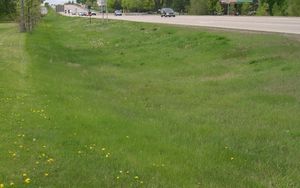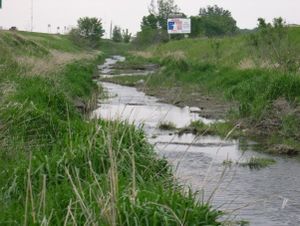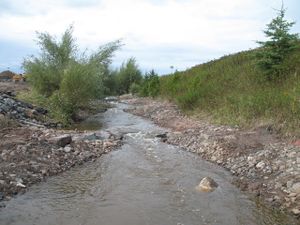
Difference between revisions of "Category:Level 3 - General information, reference, tables, images, and archives/Tables/Swales"
m |
m |
||
| Line 7: | Line 7: | ||
*Wet swales occur when the water table is located very close to the surface or water does not readily drain out of the swale. A wet swale acts as a very long and linear shallow [https://stormwater.pca.state.mn.us/index.php?title=Bioretention_terminology#General_discussion_of_types_of_bioretention_BMPs biofiltration] or [https://stormwater.pca.state.mn.us/index.php?title=Stormwater_wetlands linear wetland treatment system]. Wet swales do not provide volume reduction and have limited treatment capability. Incorporation of check dams into the design allows treatment of a portion or all of the <span title="The volume of water that is treated by a BMP."> [https://stormwater.pca.state.mn.us/index.php?title=Water_quality_criteria '''Water Quality Volume''']</span> within a series of cells created by the check dams. Wet swales planted with [https://stormwater.pca.state.mn.us/index.php?title=Plants_for_swales emergent wetland plant species] provide improved pollutant removal. Wet swales may be used as [[Pretreatment|pretreatment]] practices. Wet swales are commonly used for drainage areas less than 5 acres in size. | *Wet swales occur when the water table is located very close to the surface or water does not readily drain out of the swale. A wet swale acts as a very long and linear shallow [https://stormwater.pca.state.mn.us/index.php?title=Bioretention_terminology#General_discussion_of_types_of_bioretention_BMPs biofiltration] or [https://stormwater.pca.state.mn.us/index.php?title=Stormwater_wetlands linear wetland treatment system]. Wet swales do not provide volume reduction and have limited treatment capability. Incorporation of check dams into the design allows treatment of a portion or all of the <span title="The volume of water that is treated by a BMP."> [https://stormwater.pca.state.mn.us/index.php?title=Water_quality_criteria '''Water Quality Volume''']</span> within a series of cells created by the check dams. Wet swales planted with [https://stormwater.pca.state.mn.us/index.php?title=Plants_for_swales emergent wetland plant species] provide improved pollutant removal. Wet swales may be used as [[Pretreatment|pretreatment]] practices. Wet swales are commonly used for drainage areas less than 5 acres in size. | ||
*Stormwater step pools are defined by design features that address higher energy flows due to more dramatic slopes than <span title="Dry swales, sometimes called grass swales, are similar to bioretention cells but are configured as shallow, linear channels. They typically have vegetative cover such as turf or native perennial grasses. Dry swales may be constructed as filtration or infiltration practices, depending on soils."> [https://stormwater.pca.state.mn.us/index.php?title=Dry_swale_(Grass_swale) '''dry swales''']</span> or <span title="Wet swales occur when the water table is located very close to the surface or water does not readily drain out of the swale. A wet swale acts as a very long and linear shallow biofiltration or linear wetland treatment system."> [https://stormwater.pca.state.mn.us/index.php?title=Wet_swale_(wetland_channel) '''wet swales''']</span>. Using a series of pools, riffle grade control, <span title="A species that has been observed in the form of a naturally occurring and self-sustaining population in historical times. Non-natives do not meet this definition."> '''native species'''</span> vegetation and a sand seepage filter bed, flow velocities are reduced, treated, and, where applicable, infiltrated. The physical characteristics of the stormwater step pools are similar to [https://cfpub.epa.gov/watertrain/moduleFrame.cfm?parent_object_id=1199 Rosgen A or B stream classification types], where “bedform occurs as a step/pool, cascading channel which often stores large amounts of sediment in the pools associated with debris dams” ([https://stormwater.pca.state.mn.us/index.php?title=References_for_high-gradient_stormwater_step-pool_swale Rosgen, 1996]). These structures feature surface/subsurface runoff storage seams and an energy dissipation design that is aimed at attenuating the flow to a desired level through energy and hydraulic power equivalency principles ([https://stormwater.pca.state.mn.us/index.php?title=References_for_high-gradient_stormwater_step-pool_swale Anne Arundel County, 2009]). Stormwater step pools are designed with a wide variety of [https://stormwater.pca.state.mn.us/index.php?title=Plants_for_swales native plant species] depending on the hydraulic conditions and expected post-flow soil moisture at any given point within the stormwater step pool. | *Stormwater step pools are defined by design features that address higher energy flows due to more dramatic slopes than <span title="Dry swales, sometimes called grass swales, are similar to bioretention cells but are configured as shallow, linear channels. They typically have vegetative cover such as turf or native perennial grasses. Dry swales may be constructed as filtration or infiltration practices, depending on soils."> [https://stormwater.pca.state.mn.us/index.php?title=Dry_swale_(Grass_swale) '''dry swales''']</span> or <span title="Wet swales occur when the water table is located very close to the surface or water does not readily drain out of the swale. A wet swale acts as a very long and linear shallow biofiltration or linear wetland treatment system."> [https://stormwater.pca.state.mn.us/index.php?title=Wet_swale_(wetland_channel) '''wet swales''']</span>. Using a series of pools, riffle grade control, <span title="A species that has been observed in the form of a naturally occurring and self-sustaining population in historical times. Non-natives do not meet this definition."> '''native species'''</span> vegetation and a sand seepage filter bed, flow velocities are reduced, treated, and, where applicable, infiltrated. The physical characteristics of the stormwater step pools are similar to [https://cfpub.epa.gov/watertrain/moduleFrame.cfm?parent_object_id=1199 Rosgen A or B stream classification types], where “bedform occurs as a step/pool, cascading channel which often stores large amounts of sediment in the pools associated with debris dams” ([https://stormwater.pca.state.mn.us/index.php?title=References_for_high-gradient_stormwater_step-pool_swale Rosgen, 1996]). These structures feature surface/subsurface runoff storage seams and an energy dissipation design that is aimed at attenuating the flow to a desired level through energy and hydraulic power equivalency principles ([https://stormwater.pca.state.mn.us/index.php?title=References_for_high-gradient_stormwater_step-pool_swale Anne Arundel County, 2009]). Stormwater step pools are designed with a wide variety of [https://stormwater.pca.state.mn.us/index.php?title=Plants_for_swales native plant species] depending on the hydraulic conditions and expected post-flow soil moisture at any given point within the stormwater step pool. | ||
| + | |||
| + | This page (Category) provides links to tables that provide information on swales. | ||
Revision as of 18:42, 4 August 2022
Swales are linear features that convey water but can be configured to address water quality and quantity and perform additional functions. There are three types of swale addressed in this manual.
- Dry swales, sometimes called grass swales, are similar to bioretention cells but are configured as shallow, linear channels. Dry swales function primarily as a conveyance BMP, but provide treatment of stormwater runoff, particularly when used in tandem with check dams that temporarily retain water in a series of cells. Dry swales with an underdrain and engineered soil media are considered a filtration. Dry swales with in-situ soils capable of infiltration, (A or B soils) are considered infiltration practices. Dry swales are designed to prevent standing water. Dry swales typically have vegetative cover such as turf or native perennial grasses.
- Wet swales occur when the water table is located very close to the surface or water does not readily drain out of the swale. A wet swale acts as a very long and linear shallow biofiltration or linear wetland treatment system. Wet swales do not provide volume reduction and have limited treatment capability. Incorporation of check dams into the design allows treatment of a portion or all of the Water Quality Volume within a series of cells created by the check dams. Wet swales planted with emergent wetland plant species provide improved pollutant removal. Wet swales may be used as pretreatment practices. Wet swales are commonly used for drainage areas less than 5 acres in size.
- Stormwater step pools are defined by design features that address higher energy flows due to more dramatic slopes than dry swales or wet swales. Using a series of pools, riffle grade control, native species vegetation and a sand seepage filter bed, flow velocities are reduced, treated, and, where applicable, infiltrated. The physical characteristics of the stormwater step pools are similar to Rosgen A or B stream classification types, where “bedform occurs as a step/pool, cascading channel which often stores large amounts of sediment in the pools associated with debris dams” (Rosgen, 1996). These structures feature surface/subsurface runoff storage seams and an energy dissipation design that is aimed at attenuating the flow to a desired level through energy and hydraulic power equivalency principles (Anne Arundel County, 2009). Stormwater step pools are designed with a wide variety of native plant species depending on the hydraulic conditions and expected post-flow soil moisture at any given point within the stormwater step pool.
This page (Category) provides links to tables that provide information on swales.
Pages in category "Level 3 - General information, reference, tables, images, and archives/Tables/Swales"
The following 22 pages are in this category, out of 22 total.
D
O
S
- Sand material specifications
- Stormwater step pool construction inspection checklist
- Stormwater step pool materials specifications
- Stormwater step pool operation and maintenance checklist
- Summary of costs for dry swale case study - International Plaza Drive Improvements
- Summary of quantities - stormwater step pool case study


